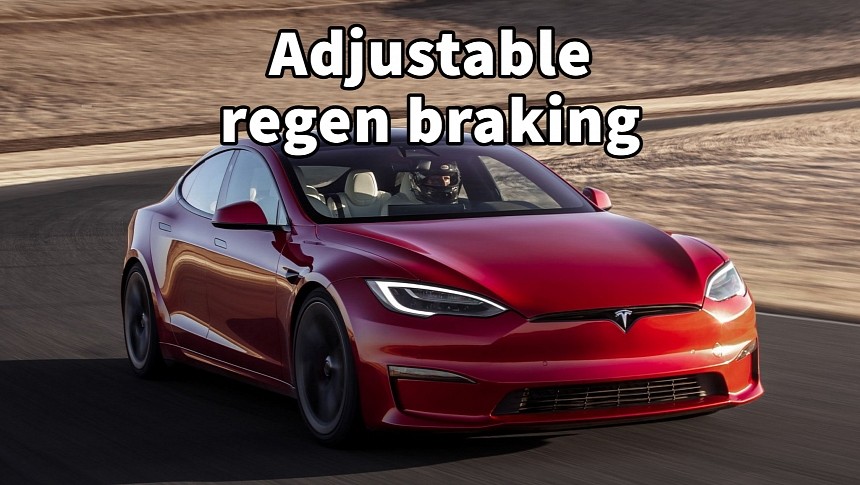The release notes of an upcoming OTA update appeared briefly in the Tesla app, and an owner was quick enough to snap a screenshot. Based on this, the 2023.6.100.1 software version will reinstate the Low regenerative braking mode and introduce changes to the Power Meter graphics.
One of the best features of electric (and hybrid, to some extent) vehicles is the option to use regenerative braking instead of friction brakes. Instead of pressing the brake pads on the rotors, the electric motors create resistance while generating electricity. This not only ensures energy recovery during braking, but also helps conserve brake pads and rotors, which last longer than in combustion-engine vehicles. Regen braking can increase the range by up to 10 percent and extend the life of brake components by up to 50 percent.
In many EVs, the level of regenerative braking can be adjusted to better suit a driver's preferences. Tesla offered two regen braking levels for its vehicles, although it withdrew the option in 2020. Only the Track Mode of Play and Performance models now offer adjustable regen braking, but this is set to change. An upcoming update of the 2023.6 branch reinstates the low regenerative braking mode to Tesla vehicles. If you're unfamiliar, the 2023.6 branch introduced FSD Beta V11.4 last week with the 2023.6.15 update.
The 2023.6.100.1 software version brings several new features, but the regenerative braking setting is the most important that we know of. According to the release notes available briefly in the Tesla app before being withdrawn, drivers can choose the amount of generative braking applied when they release the accelerator pedal. Two levels are available, Standard and Low. The Standard model, the only one available lately, provides maximum braking when releasing the accelerator, slowing down the vehicle.
The Low setting allows the vehicle to coast further and will take longer to slow down, being better suited for people new to electric cars. Some people say it is better for use in slippery conditions, as it is less likely to cause the vehicle to lose adherence. Drivers can also lift the foot off the accelerator during long drives without causing the car to slow down aggressively. However, using the low regen mode may result in reduced range and increased brake wear, being a trade-off between comfort and efficiency.
Another change brought in the 2023.6.100.1 update is the design change of the Power Meter. This is a horizontal line that appears above the car status area of the touchscreen to show real-time power usage and regenerative braking. It's one of the many changes Tesla operated to the power meter's design, this time reverting it to a thinner line. Still, the thickness increases as the driver presses the accelerator pedal, or the regen braking becomes significant.
The 2023.6.100.1 update has not been deployed to Tesla cars yet, based on the Not A Tesla App tracker. Even if it would not land in customers' cars, subsequent updates will take over and offer these new features for everyone. It's nice that Tesla provides more options to drivers, even if they are not the most energy-efficient ones.
In many EVs, the level of regenerative braking can be adjusted to better suit a driver's preferences. Tesla offered two regen braking levels for its vehicles, although it withdrew the option in 2020. Only the Track Mode of Play and Performance models now offer adjustable regen braking, but this is set to change. An upcoming update of the 2023.6 branch reinstates the low regenerative braking mode to Tesla vehicles. If you're unfamiliar, the 2023.6 branch introduced FSD Beta V11.4 last week with the 2023.6.15 update.
The 2023.6.100.1 software version brings several new features, but the regenerative braking setting is the most important that we know of. According to the release notes available briefly in the Tesla app before being withdrawn, drivers can choose the amount of generative braking applied when they release the accelerator pedal. Two levels are available, Standard and Low. The Standard model, the only one available lately, provides maximum braking when releasing the accelerator, slowing down the vehicle.
The Low setting allows the vehicle to coast further and will take longer to slow down, being better suited for people new to electric cars. Some people say it is better for use in slippery conditions, as it is less likely to cause the vehicle to lose adherence. Drivers can also lift the foot off the accelerator during long drives without causing the car to slow down aggressively. However, using the low regen mode may result in reduced range and increased brake wear, being a trade-off between comfort and efficiency.
Another change brought in the 2023.6.100.1 update is the design change of the Power Meter. This is a horizontal line that appears above the car status area of the touchscreen to show real-time power usage and regenerative braking. It's one of the many changes Tesla operated to the power meter's design, this time reverting it to a thinner line. Still, the thickness increases as the driver presses the accelerator pedal, or the regen braking becomes significant.
The 2023.6.100.1 update has not been deployed to Tesla cars yet, based on the Not A Tesla App tracker. Even if it would not land in customers' cars, subsequent updates will take over and offer these new features for everyone. It's nice that Tesla provides more options to drivers, even if they are not the most energy-efficient ones.






